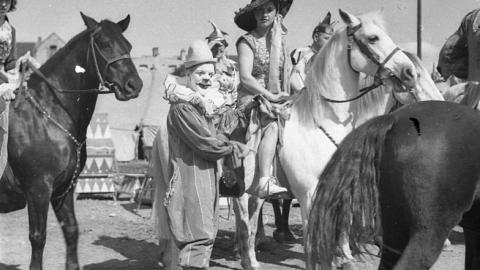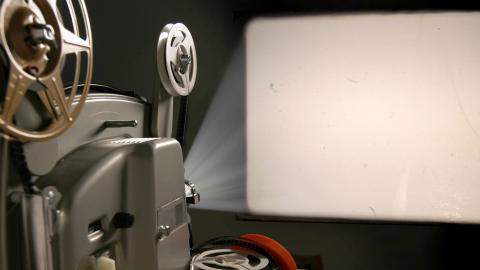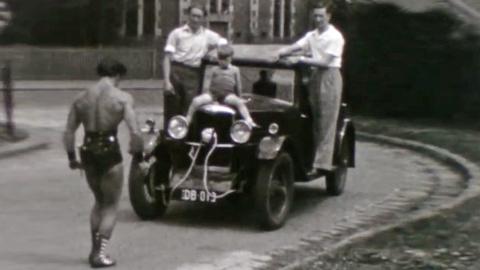

Wirth's Circus home movies
The circus comes to town! Film curator Tara Marynowsky looks at a preserved collection of 16mm home movies of Wirth’s Circus and the family that ran it.

Wirth’s Circus was Australia’s largest and most prestigious circus company. For eight decades Wirth’s was billed as Australia’s own ‘Greatest Show on Earth’, and was a huge travelling circus with an international reputation.
The children of German-born Johannes Wirth and his English wife Sarah formed the circus – John, Harry, Philip, George, Marizles, Mina and Madeline. Beginning as a small travelling band, they soon became a variety troupe and had established themselves as a small circus by 1882.
Wirth’s grew rapidly: extended (and adopted) family members featured as artists; they embarked on significant world tours and were the first Australian circus to perform in England; they travelled Australia extensively (by horse-drawn wagon and special trains); they boasted an exotic menagerie of animals ‘beautiful and marvellously trained’ and recruited many star attractions from Europe and America, ranging from Captain McCloud’s Wild West Show (1905) to the Rioguku Japanese Troupe (1917).
George and Philip Wirth
After the sudden deaths of brothers John (in 1894) and Harry (1895), George and Philip were left to manage the circus along with their sister Marizles. During the early 1900s, Wirth’s endured bitter rivalry on Australian soil with their major competition – the FitzGerald Bros Circus – though Wirth’s dominated after Dan and Tom Fitzgerald died in 1906. By 1907 they established Wirth’s Park in Melbourne which included its own circus Hippodrome, rollerskating rink, race track, water chute and lake. Wirth’s flourished as Australia’s premier circus and millions of Australians went to see them.

It is George and Philip Wirth who have primarily been written into Australian circus history folklore. Both brothers were talented performers, musicians, acrobats, animal trainers and ringmasters. George (born in 1867) retired from the circus in 1930 and died in 1941. He was married to Margaret Wirth (nee Bain) and they had no children.
Philip (born 1864) died in 1937 at his home ‘Ocean View’ in Coogee, Sydney. He married twice; his second marriage was to Alice Maud Wirth (nee Willis). Philip had seven children and it was they (along with extended family) who continued to run the circus until its demise in 1963.
Wirth family films
During the past five years the NFSA has acquired approximately 50 × 16mm home movies and several audio recordings related to the Wirth family and Wirth’s Circus. While these collections have come from a range of clients, the majority were donated by direct descendants of the Wirth family and link back to George and Philip Wirth. Most of the films suffered from shrinkage, warping, buckling and brittleness but only a few reels were not salvageable. After 12 months’ work, the entire collection is now fully preserved at the NFSA both in its original format and digitally.
The collection covers 1925 to the 1950s. As seen in the films, George is a small but well-built man who loved swimming and could still do a backward somersault in his late 60s; Philip has a much broader frame, is large in height and often seen sporting a moustache and bowler hat.

George is presumed to have been the key home-movie maker, with his wife Margaret behind the camera when George is in shot. When George retired from the ‘hurly burly’ of the circus in 1930 he became a director at Pagewood (film) Studios. George and Margaret extensively travelled overseas and took many home movies during their trip to the United States where they visited May Wirth – said to be ‘the greatest lady bareback rider in the world’. May was inducted into the Circus Hall of Fame in 1963.
The following are my highlights from the collection; these films best capture the spirit of the circus and its folklore. The home movie segments include digitised sound recordings of Philip Wirth playing either the tin whistle or the French horn. Philip took up the tin whistle in his later years and would often play music in the circus ring during performances.
Circus sounds and smells
In this sound recording, Circus Life with Wirth’s (c. 1950), Marjory Green interviews Harry Moreni for a New Zealand radio program. The recording captures the spirit of the Wirths and their devoted passion for their work. Harry speaks fondly of Margaret Wirth (George’s wife) and recalls stories about the elephants. The circus, he says, has a distinctive smell: ‘some people may find [it] objectionable, but to me it’s just like a lovely perfume’.
Circus Life With Wirth's, c1930. NFSA title: 1068153
The earliest Wirth’s Circus footage
Wirth’s Circus: Behind the Big Top (c. 1928) is the earliest circus footage in the collection and goes behind the scenes of a big top production. In this film we see George holding his 16mm film camera; 16mm film had been introduced as a less expensive amateur alternative to 35mm only five years earlier.
Wirth's Circus: Behind the Big Top, c.1928. NFSA title: 759317
Ocean View
Wirth’s Circus: At Ocean View, Coogee (c. 1930) features an exotic theatrical play circus shot on the grounds of Philip Wirth’s home ‘Ocean View’, which he built in 1926. The grand heritage-listed mansion stayed with the extended Wirth family until it was sold in 2009. ‘Princess Alice’, one of Wirth’s most famous circus elephants, is rumoured to be buried on the grounds and it is believed that circus animals were occasionally accommodated here.
Wirth's Circus: At Ocean View, Coogee, c.1930. NFSA title: 759317
The circus in Sydney
George and Philip Wirth lived in Sydney and many of their films document Sydney and its harbour. But Wirth’s Circus: Sydney (c. 1936) is one of the few to include the circus in Sydney. Newspaper advertisements from the period state that the entrance to the Sydney location of Wirth’s Circus was behind Buckingham’s, on Oxford St between Riley and Goulburn streets, Surry Hills.
Wirth's Circus in Sydney, c.1936. NFSA title: 759317
Wirth women and elephants
The women of the Wirth families contributed to the circus in many ways. Wirth’s Circus: The Elephants Arrive (c. 1936) features a procession of elephants wearing decorative costume rugs designed and made by Margaret Wirth (George’s wife), who also designed many of the costumes for Wirth’s. The horse-riding woman is believed to be Philip Wirth’s daughter, Eileen May Wirth, who was also an elephant trainer and ringmaster.
Wirth's Circus: The Elephants Arrive, c.1936. NFSA title: 759317
With thanks to Margaret and Georgina Wirth, Mick and Robyn Wordley, Gayle Speight, Mark St Leon and Peter Cox.
See more circus films in our Circus curated collection.
The National Film and Sound Archive of Australia acknowledges Australia’s Aboriginal and Torres Strait Islander peoples as the Traditional Custodians of the land on which we work and live and gives respect to their Elders both past and present.


